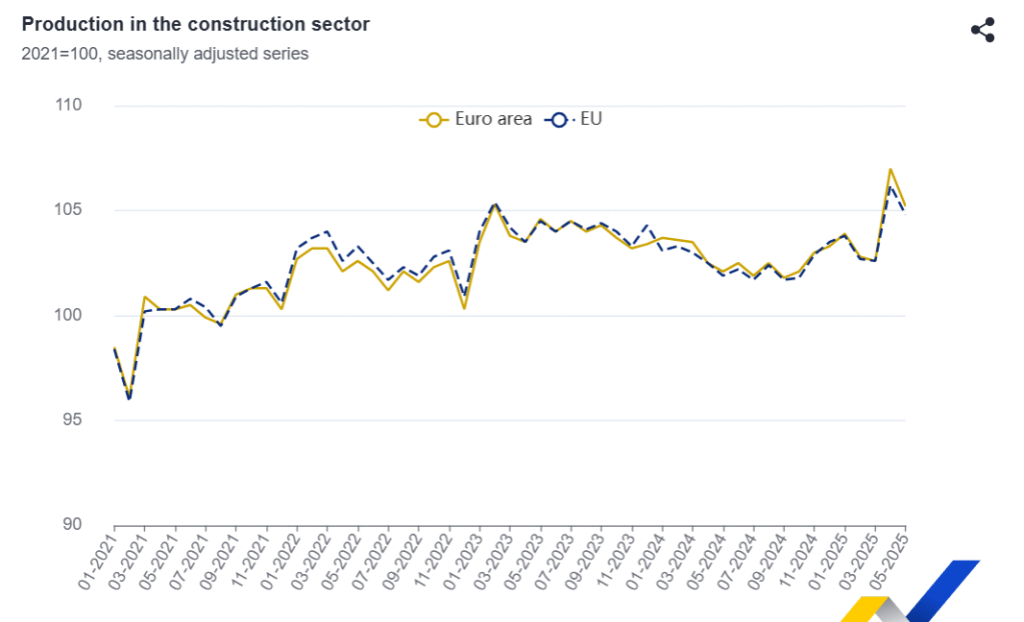EU Construction Sector Sees Mixed Momentum:In May 2025, construction production in the euro area dropped by 1.7% and by 1.3% in the EU compared to April 2025, according to Eurostat. This follows a strong upward revision in April’s growth figures. Despite the monthly decline, production rose 2.9% in the euro area and 2.7% in the EU year-on-year. The largest monthly declines were seen in Germany, Belgium, and the Netherlands, while Slovenia, Hungary, and Czechia saw increases. On an annual basis, Spain led with a 44.6% rise in construction output, while Poland, Germany, and France saw declines.
EU Construction Sector Sees Mixed Momentum
According to the latest data from Eurostat, the construction sector across the euro area and the European Union (EU) experienced a decline in May 2025, reversing part of the strong gains seen in April. The seasonally adjusted production in construction fell by 1.7% in the euro area and by 1.3% in the EU in May compared with April 2025.
This monthly decline in EU Construction follows a significant upward revision of April 2025 figures. Eurostat updated April’s growth from 1.7% to 4.3% for the euro area and from 1.4% to 3.5% for the EU. These revisions indicate that while May saw a downturn, the sector had previously shown robust recovery momentum.
On an annual basis, production in EU construction in May 2025 increased by 2.9% in the euro area and by 2.7% in the EU compared with May 2024. The year-on-year growth signals that, despite the monthly drop, the sector continues to expand overall.

Breakdown by Sector: Monthly Comparison
In the EU Construction area, the May 2025 monthly decline was reflected across all sub-sectors:
- Construction of buildings decreased by 1.3%
- Civil engineering declined by 0.7%
- Specialised construction activities dropped by 1.7%
The E recorded slightly more moderate declines:
- Construction of buildings was down by 0.4%
- Civil engineering slipped by 0.5%
- Specialised construction activities decreased by 1.3%
Country-Level Performance
Among the Member States for which data is available, the sharpest monthly declines were seen in:
- Germany: -3.9%
- Belgium: -2.2%
- Netherlands: -1.8%
On the other hand, some countries reported strong monthly gains:
Annual Growth by Construction Segment
- Slovenia: +5.4%
- Hungary: +2.5%
- Czechia: +2.3%
Compared with May 2024, the production in construction across the euro area increased in all key sub-sectors:
- Construction of buildings rose by 6.4%
- Civil engineering increased by 2.9%
- Specialised construction activities grew by 1.0%
In the EU:
- Construction of buildings went up by 5.3%
- Civil engineering advanced by 3.3%
- Specialised construction activities increased by 1.1%
Country-Level Annual Comparison
Some countries stood out with significant year-on-year gains in construction production:
- Spain: +44.6%
- Czechia: +11.6%
- Hungary and Portugal: +5.4% each
However, a few major economies reported annual declines:
- Poland: -4.8%
- Germany: -3.4%
- France: -3.3%
Methodology and Scope
Eurostat’s index of production in EU construction estimates volume trends in the sector, segmented by building construction, civil engineering, and specialised activities, following the NACE Rev. 2 classification. The data are seasonally adjusted, and euro area and EU aggregates are compiled using national statistics, with missing data points estimated where necessary.
It’s important to note that some Member States—specifically Estonia, Greece, Croatia, Cyprus, Latvia, Lithuania, Luxembourg, and Malta—are not obligated to submit monthly data within 1 month and 15 days post-reference period as per Regulation (EU) 2019/2152.
Conclusion
While the euro area and EU construction sectors saw a short-term dip in May 2025, the overall annual trajectory remains positive. April’s revised figures suggest that the industry experienced a strong rebound earlier this year. However, the latest data also highlights regional disparities and the continued sensitivity of the construction sector to macroeconomic fluctuations.
Disclaimer:
The information presented in this article is based on data published by Eurostat and is intended for informational and analytical purposes only. While every effort has been made to ensure accuracy, the data is subject to revisions and updates by official statistical agencies. Readers are advised to consult the original Eurostat release or other official sources for the most up-to-date and detailed information. This article does not constitute financial or investment advice.

